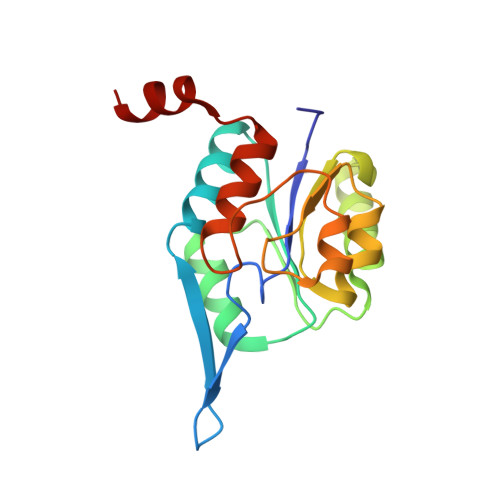Structure-Function Analysis of 2-Keto-3-deoxy-D-glycero-D-galactonononate-9-phosphate Phosphatase Defines Specificity Elements in Type C0 Haloalkanoate Dehalogenase Family Members.
Lu, Z., Wang, L., Dunaway-Mariano, D., Allen, K.N.(2009) J Biol Chem 284: 1224-1233
- PubMed: 18986982
- DOI: https://doi.org/10.1074/jbc.M807056200
- Primary Citation of Related Structures:
3E81, 3E84, 3E8M - PubMed Abstract:
The phosphotransferases of the haloalkanoate dehalogenase superfamily (HADSF) act upon a wide range of metabolites in all eukaryotes and prokaryotes and thus constitute a significant force in cell function. The challenge posed for biochemical function assignment of HADSF members is the identification of the structural determinants that target a specific metabolite. The "8KDOP" subfamily of the HADSF is defined by the known structure and catalytic activity of 2-keto-3-deoxy-8-phospho-d-manno-octulosonic acid (KDO-8-P) phosphatase. Homologues of this enzyme have been uniformly annotated as KDO-8-P phosphatase. One such gene, BT1713, from the Bacteroides thetaiotaomicron genome was recently found to encode the enzyme 2-keto-3-deoxy-d-glycero-d-galacto-9-phosphonononic acid (KDN-9-P) phosphatase in the biosynthetic pathway of the 9-carbon alpha-keto acid, 2-keto-3-deoxy-d-glycero-d-galactonononic acid (KDN). To find the structural elements that provide substrate-specific interactions and to allow identification of genomic sequence markers, the x-ray crystal structures of BT1713 liganded to the cofactor Mg(2+)and complexed with tungstate or VO(3)(-)/Neu5Ac were determined to 1.1, 1.85, and 1.63 A resolution, respectively. The structures define the active site to be at the subunit interface and, as confirmed by steady-state kinetics and site-directed mutagenesis, reveal Arg-64(*), Lys-67(*), and Glu-56 to be the key residues involved in sugar binding that are essential for BT1713 catalytic function. Bioinformatic analyses of the differentially conserved residues between BT1713 and KDO-8-P phosphatase homologues guided by the knowledge of the structure-based specificity determinants define Glu-56 and Lys-67(*) to be the key residues that can be used in future annotations.
Organizational Affiliation:
Department of Chemistry, Boston University, Boston, Massachusetts 02215-2521, USA.





















